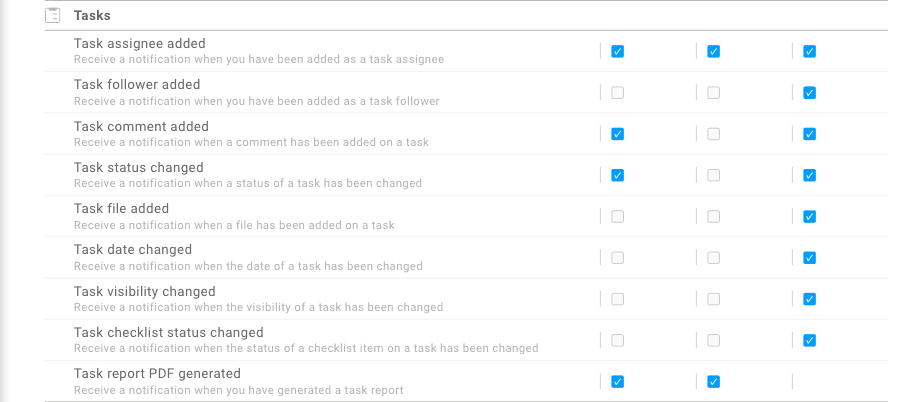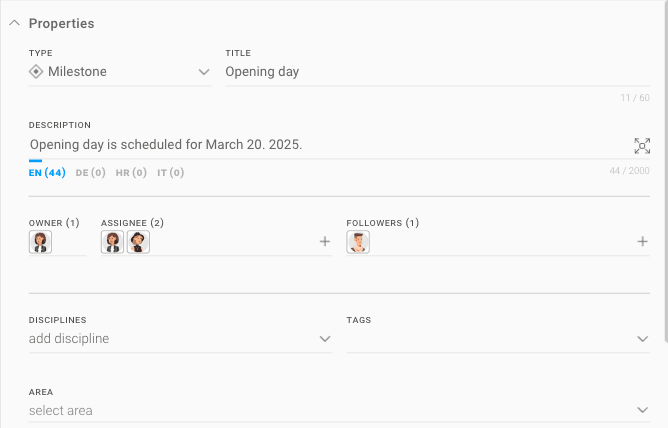Introduction
The Tasks module in VOLUM3 is designed for tracking issues, assigning responsibilities, and managing workflows across project teams. It ensures clear communication, accountability, and seamless coordination, making it especially valuable for construction and architectural projects.
With Tasks, users can:
- Create and assign tasks to team members.
- Track progress using statuses to monitor workflow.
- Attach documents, images, and drawings for better context.
- Collaborate efficiently through mentions and comments.
- Link tasks to drawings and other project elements to maintain spatial and project-wide connections.
- Utilize tasks within meetings, a unique VOLUM3 integration, allowing teams to directly connect discussions with actionable items.
By integrating task management with meetings and other Volum3 modules, teams can streamline decision-making, enhance efficiency, and ensure project success.
Accessing the Task Module
To open the Tasks module in VOLUM3, navigate to the left menu and click on Tasks.
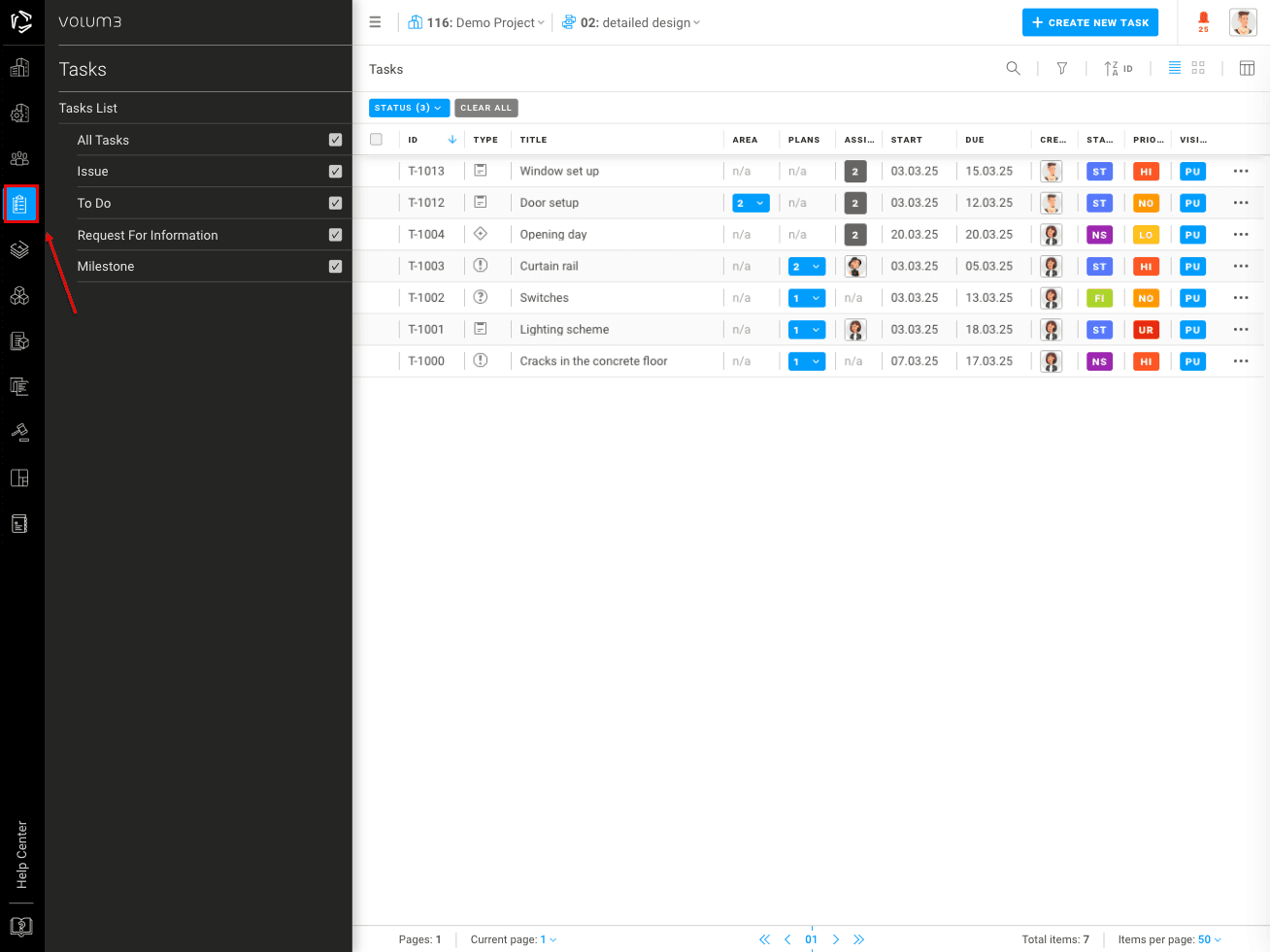
Screen Overview
The Tasks module consists of several main screens:
- Task List (main screen with all project tasks)
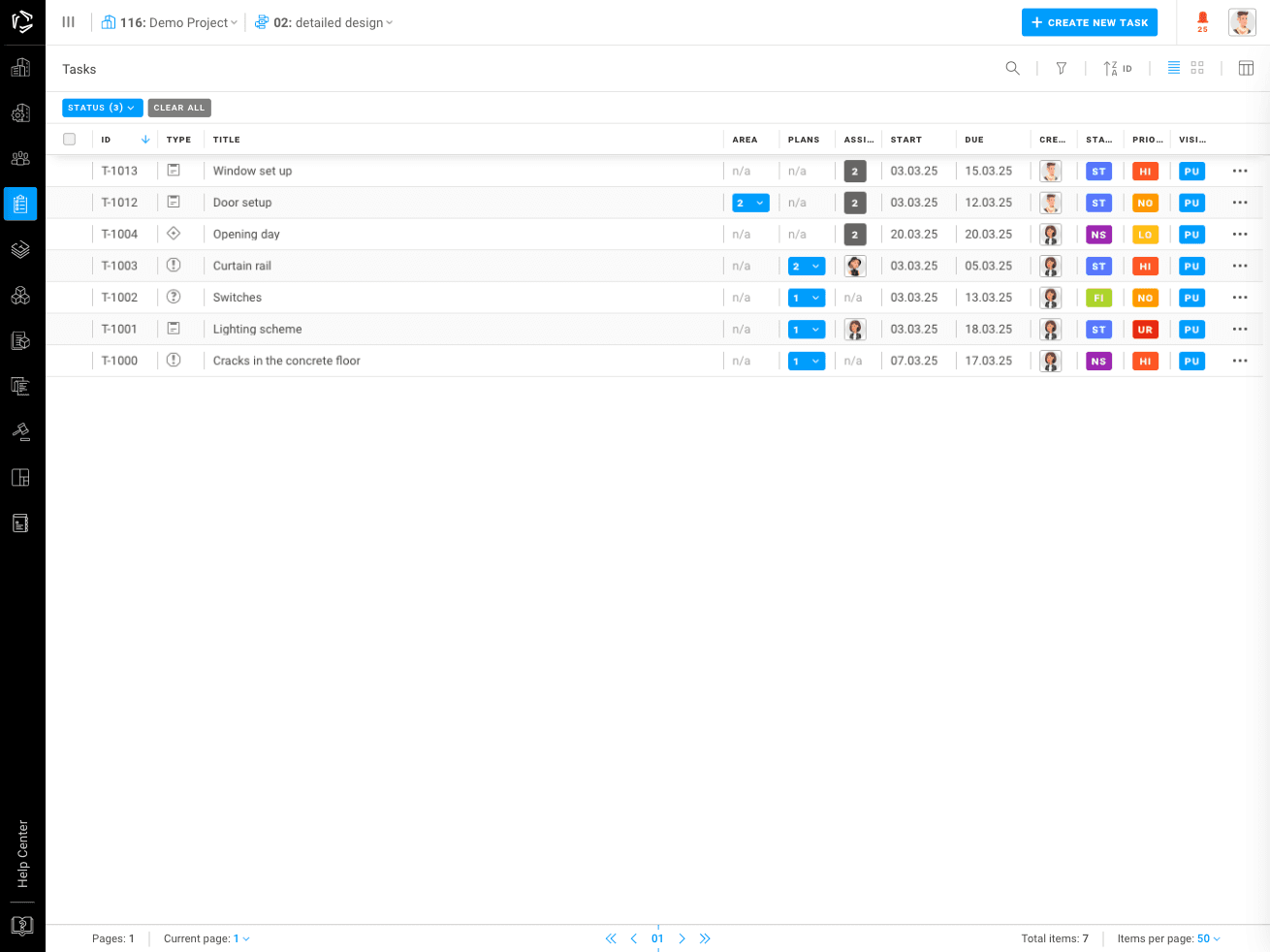
- Task Flyout (detailed view of an individual task)
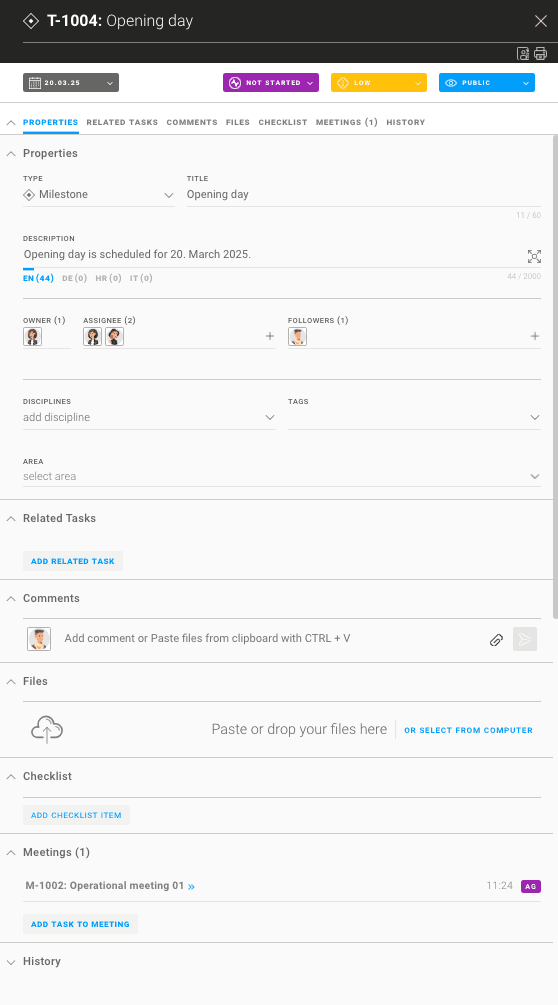
- Task Creation Modal (window for adding a new task)
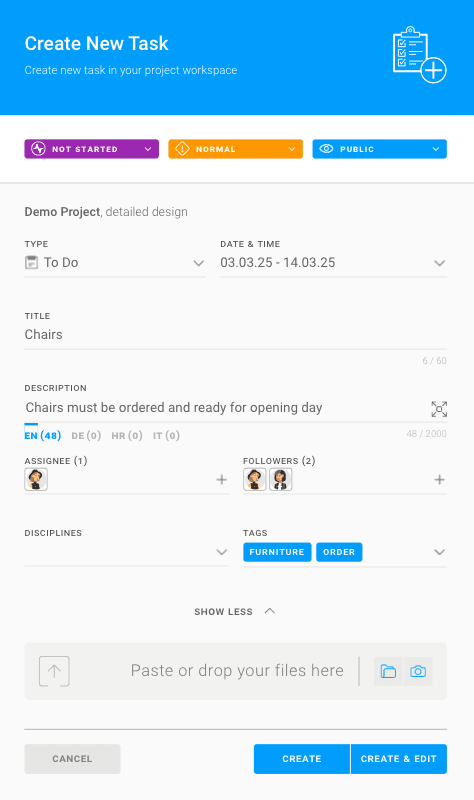
Tasks List
The Tasks List View is the central hub for managing all project tasks. Each task is displayed in a structured table with columns.
Default Columns
- ID
- Type
- Area
- Plans
- Assignee
- Start
- Due
- Created by
- Status
- Priority
- Visibility
Additional Columns
These columns can be enabled manually:
- Comments
- Checklist Items
- Files
- Meetings
- Updated at
- Created At
- Finished at
The Reset to Default button in VOLUM3 restores the task table settings to factory settings, enabling only the default columns while hiding any additional columns that were manually selected. This allows users to quickly revert to the original view without needing to adjust individual settings.
Show/Hide Columns
Users in VOLUM3 can customize their task view by adding or removing columns to display only relevant information. By clicking on the column settings menu, users can enable or disable specific columns, tailoring the table layout to their needs. This flexibility allows for a more efficient and personalized workflow, ensuring that only the most important data is visible at any given time.
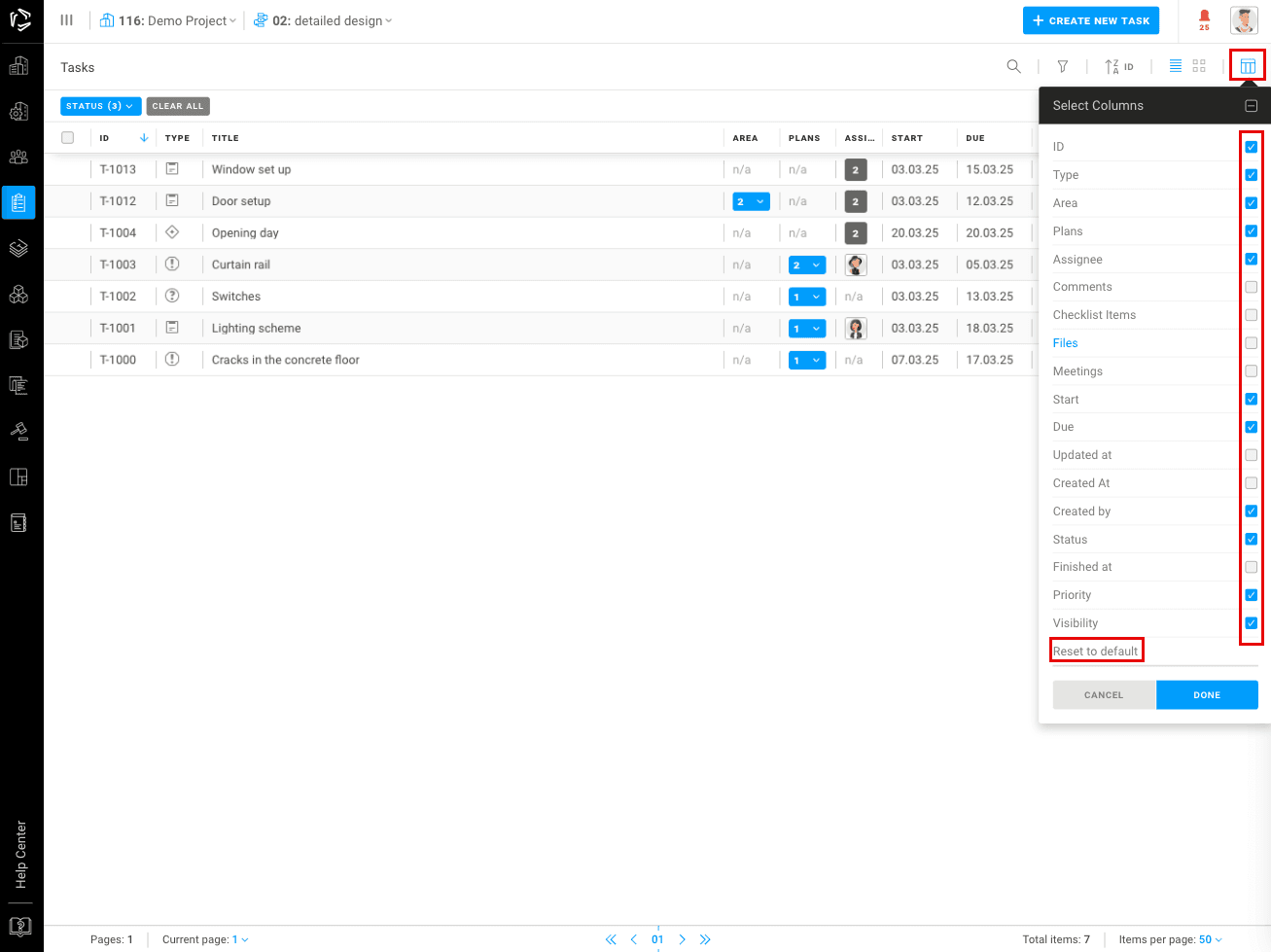
Filters
Filters are one of the most powerful features in VOLUM3, allowing users to quickly find relevant tasks as task lists grow. Users can filter tasks based on status, assigned users, deadline date, tags, and general date ranges, ensuring efficient navigation and task management. Multiple filters can be applied simultaneously, and the filtering logic is additive, meaning a larger set of data is displayed when multiple filters are used together.Available filters in task list are:
- Status – Filters tasks based on their current progress, such as Not Started, Started, Finished, Closed or Canceled
- Created By – Filters tasks by the user who originally created them.
- Assignee – Shows tasks assigned to a specific user, helping track individual responsibilities.
- Follower – Filters tasks where a user is listed as a follower, ensuring they stay updated on relevant work.
- Priority – Allows filtering tasks by urgency, including Low, Normal, High, and Urgent.
- Visibility – Filters tasks based on whether they are Public (visible to all project participants) or Private (restricted to task owners, assignees, and followers).
- Tag – Enables filtering by tags assigned to tasks, improving categorization across projects.
- Meeting – Shows tasks that are linked to a specific meeting, ensuring related discussions and actions are easily accessible.
- Discipline – Filters tasks based on predefined project disciplines, such as Architecture, Structural, or MEP, for better organization.
- Environment – Allows filtering tasks based on environmental conditions or specific project-related settings.
- Sites – Filters tasks by specific project sites, useful for multi-site projects or phased developments.
- Buildings – Displays tasks related to specific buildings within a project, useful for large developments with multiple structures.
- Storeys – Filters tasks by building floors or levels, making it easier to track work per floor.
- Rooms – Allows filtering of tasks linked to specific rooms, useful for detailed project coordination.
- Room Types – Filters tasks by room categories such as offices, bathrooms, or storage spaces.
- Room Groups – Groups tasks by room clusters or predefined categories, aiding in large-scale organization.
- Zones – Filters tasks by designated project zones, such as residential, commercial, or service areas.
- Entrances – Displays tasks related to specific building or site entrances.
- Expansion Joints – Filters tasks concerning expansion joints, ensuring structural considerations are tracked.
- Start / Due – Allows filtering based on task start and due dates to track scheduling and deadlines.
- Finished Date – Filters tasks by their completion date for reviewing past work.
- Created At – Shows tasks based on when they were initially created, helping with project history tracking.
- Last Changed – Filters tasks based on the most recent updates or modifications.
For convenience, the most frequently used filters can be pinned to the toolbar, providing quick access to commonly applied filters and improving workflow efficiency.
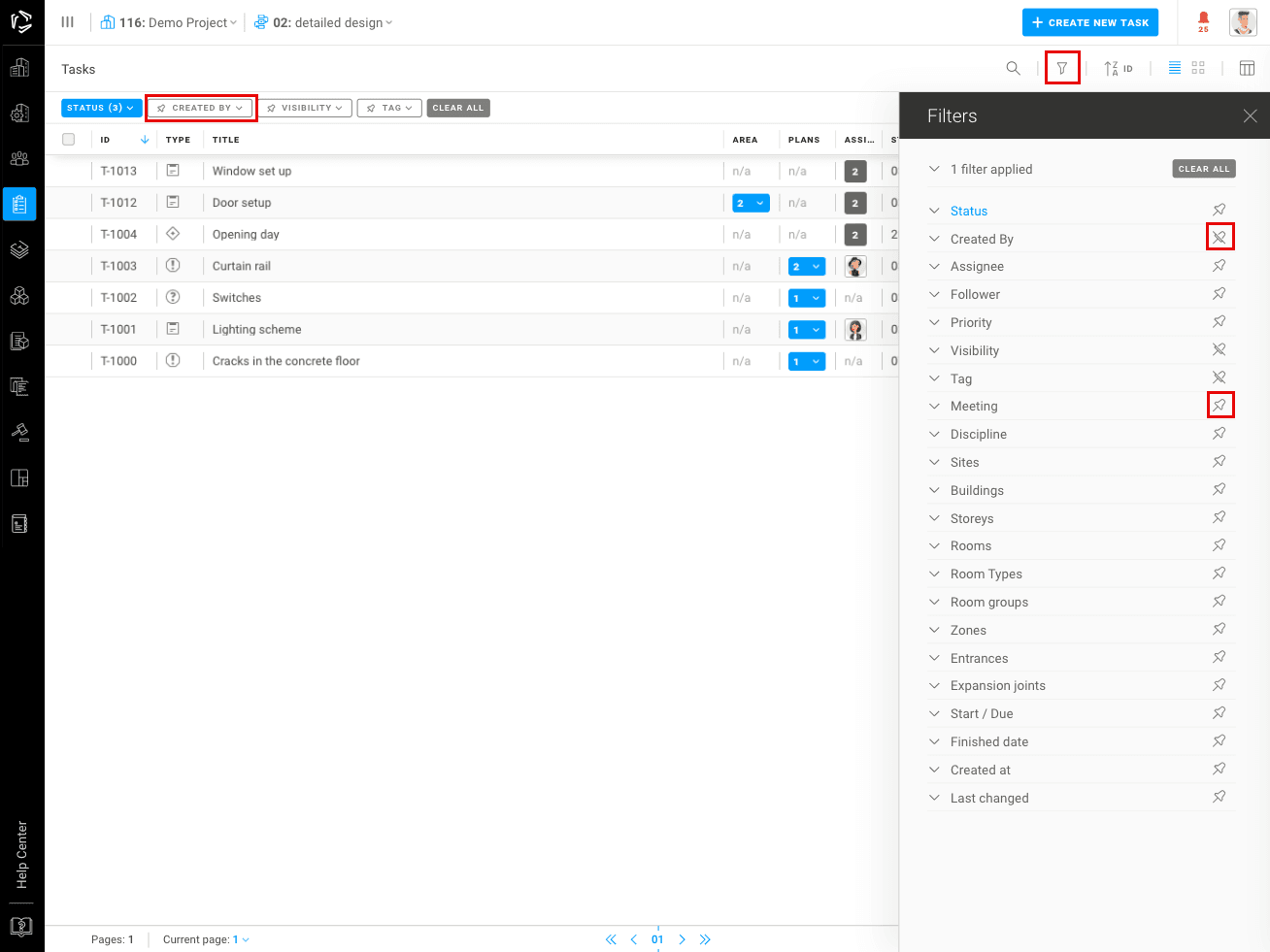
Search
Users in VOLUM3 can search for tasks using keywords, making it easier to locate specific items. The search function looks through key fields, including Task Title, Task Description, task tag (name), Task number (task identifier) and the first and last name of the task creator.
Task comments are also searchable, including the comment text and the name of the comment creator.
Search works in combination with filters, allowing users to refine results and quickly find relevant tasks within large lists.
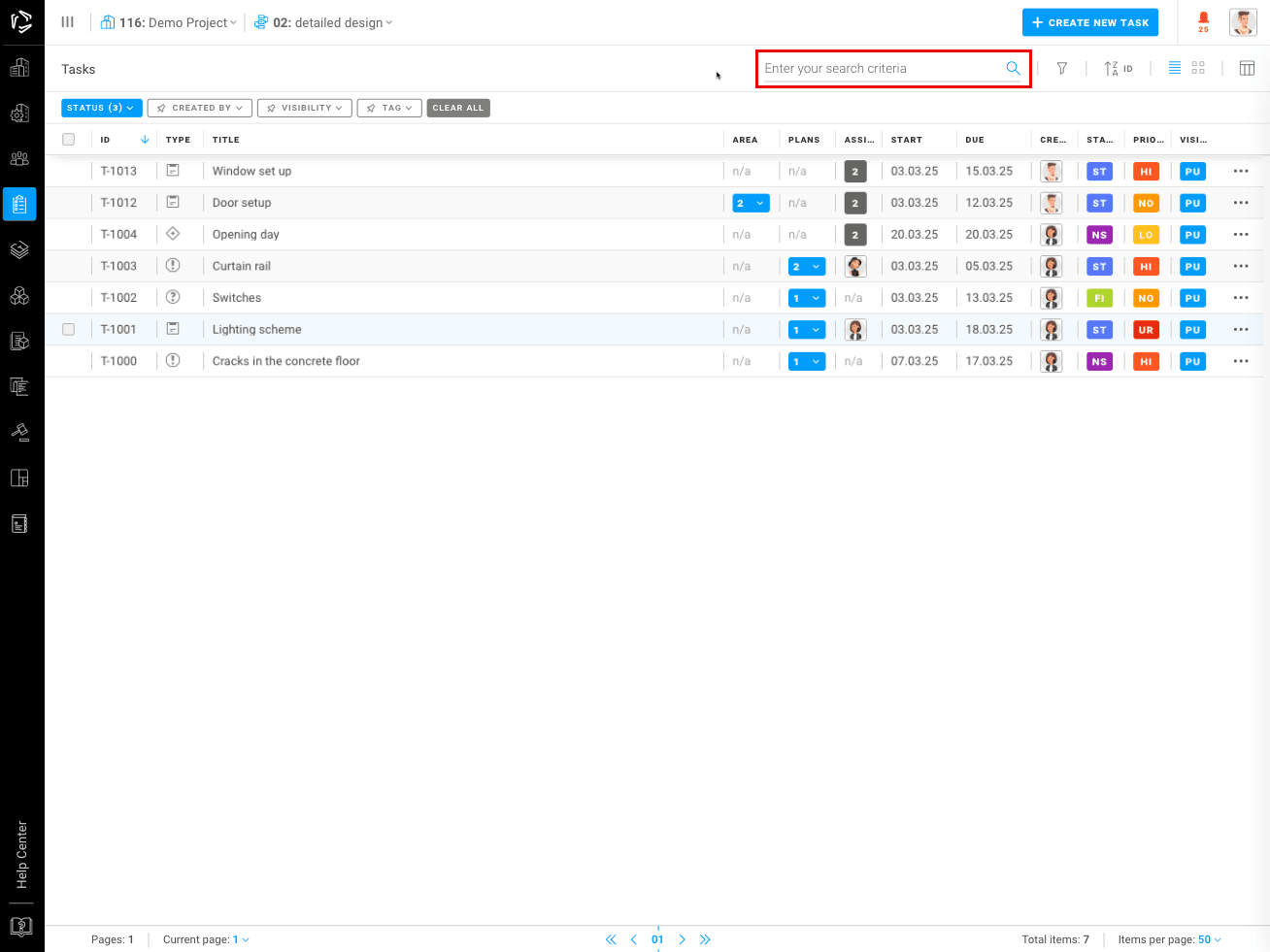
Sorting Task Table
Users in VOLUM3 can sort the task table by any column, including task number, due date, priority, or status. By default, tasks are sorted by task ID T-1000. Users can change the sorting order by clicking on the column name, and an arrow icon next to the column indicates the sorting direction.
Furthermore, a dropdown menu located in the upper right section of the screen allows users to choose a sorting option.
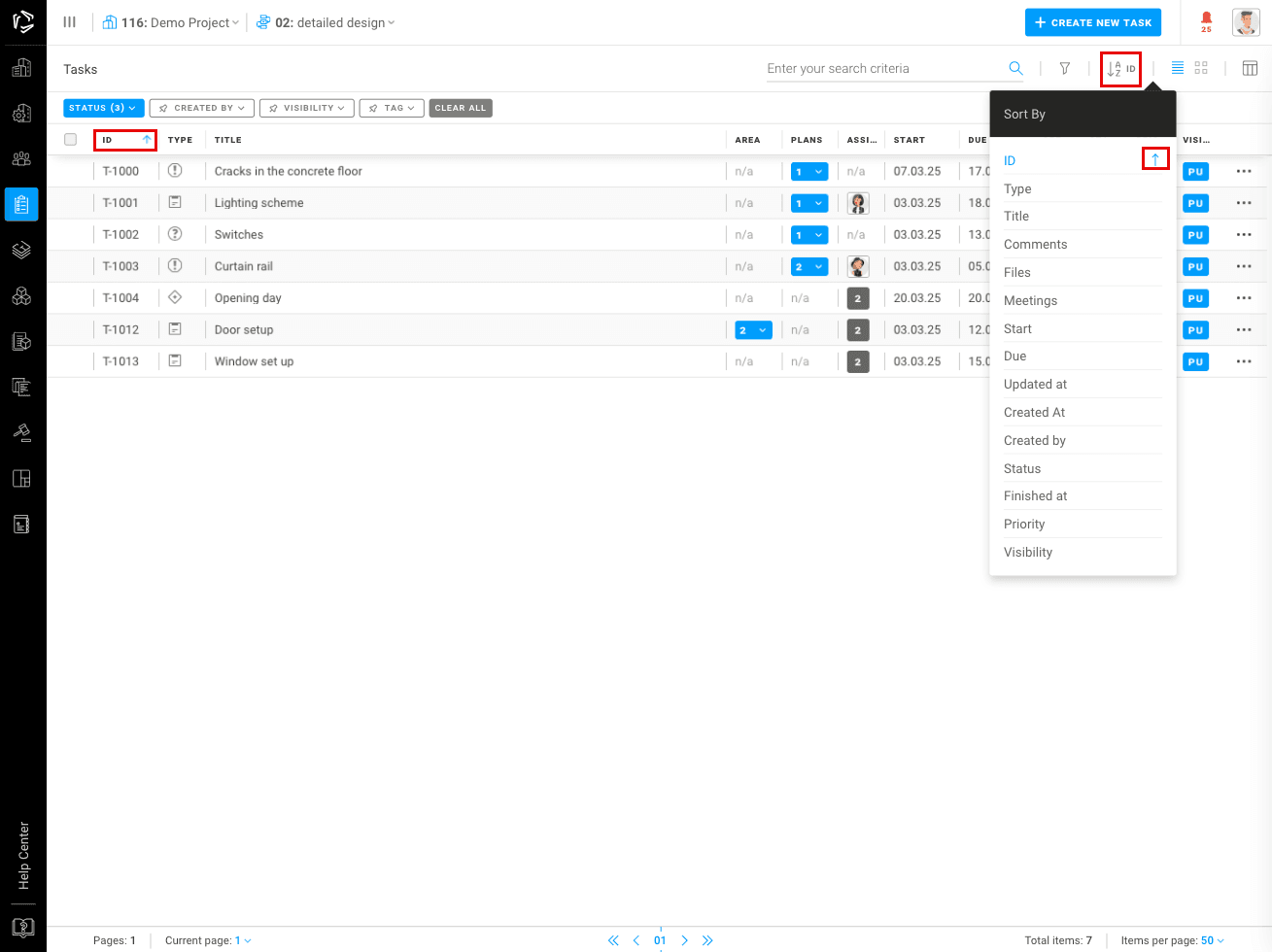
Creating a Task
Tasks in VOLUM3 can be created through multiple entry points for better workflow integration:
- Tasks Module – Click the + Create New Task button within the Tasks module.
- Plans Module – To create a task, click on the pin icon located on the toolbar, then place the task directly onto your desired position
- Meetings Module – Add a task during a meeting by clicking + ADD New Task to ensure discussions are actionable.
Create New Task Window
To create a Task:
1. Click the “+ CREATE NEW TASK” button in the upper-right corner.
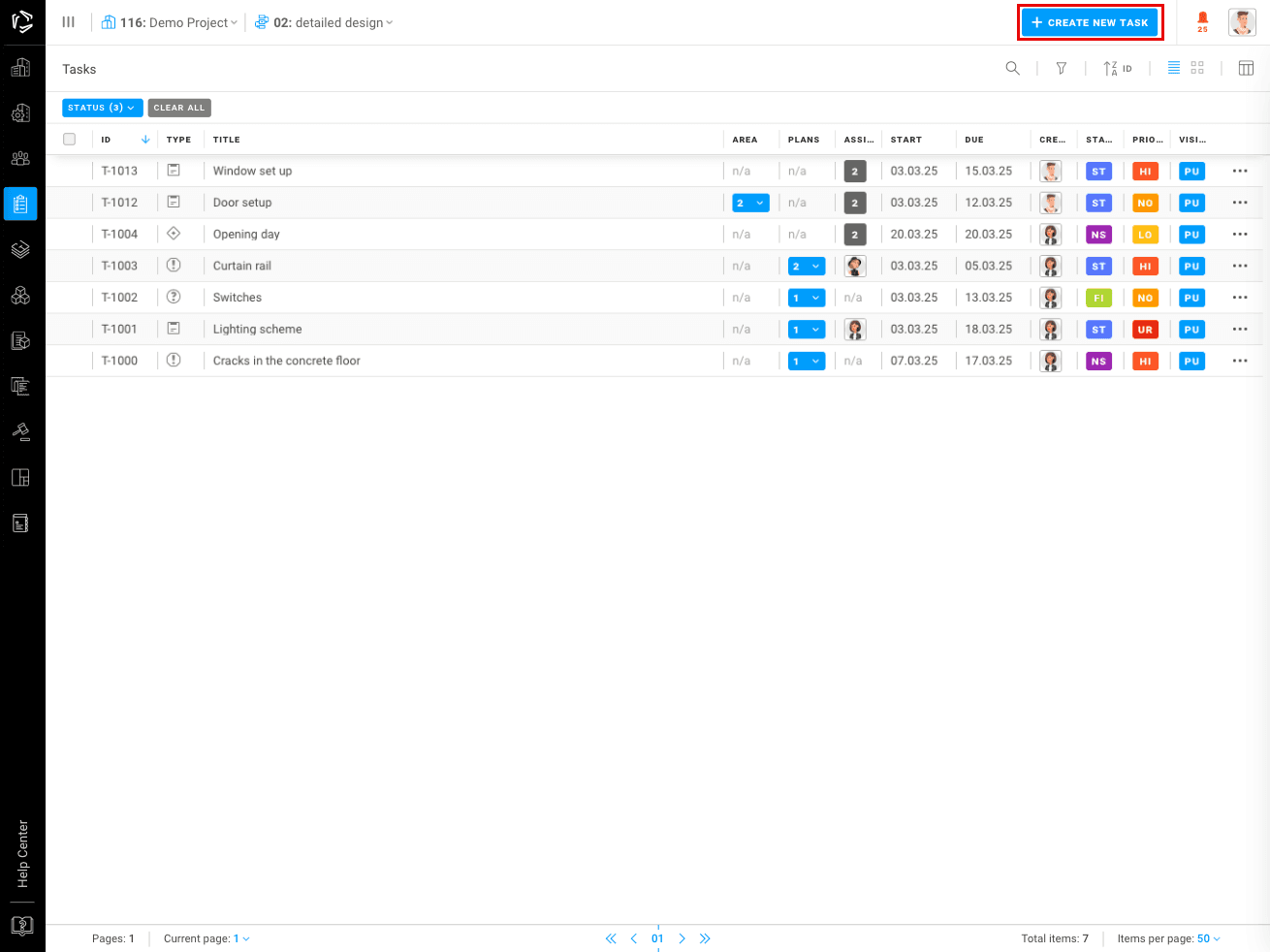
2. A Pop-up Wizard will appear - in the wizard fill in all the mandatory fields. Click the “CREATE” button to create your task.

When creating a new Task in VOLUM3, you can customize type, date, time, and settings to match task requirements.
- Type – Select from options such as For Your Information, Request for Information, Decision, To Do, Milestone, or Issue.
- Date & Time – Define scheduling details, including creation and update timestamps, ensuring accurate progress tracking.
- Task Title – Enter a short description of up to 70 characters.
- Task Description – Provide a detailed description, up to 2000 characters, including instructions and relevant details.
- Languages – Add task descriptions in multiple languages based on project settings to support multilingual collaboration.
- Assignee – Select the user responsible for completing the task, preferably only one for clarity.
- Follower – Choose users who need to stay informed about the task but are not directly responsible.
- Files – Upload documents, paste images, or if using a mobile phone, take a photo and attach it directly to the task.
- Show More/Show less – Expands or collapses additional settings, allowing users to add Tags and Disciplines to better categorize the task or ignore them completely.
note
User Rights in Task Module – Permissions in VOLUM3 are inherited from the project / stage and based on user roles:
- Editor – Can create and edit assigned tasks.
- Reviewer – Can comment and provide feedback, but cannot edit or add content.
- Viewer – Can only view tasks without making modifications.
Task Flyout Window
The Task Flyout Window in VOLUM3 is a side panel that appears from the right side of the browser, serving as the central place for editing task details.
It is structured into multiple tabs for better navigation, allowing users to update task information without leaving the current view. This streamlined approach ensures that all relevant task details remain easily accessible, improving efficiency and workflow management.
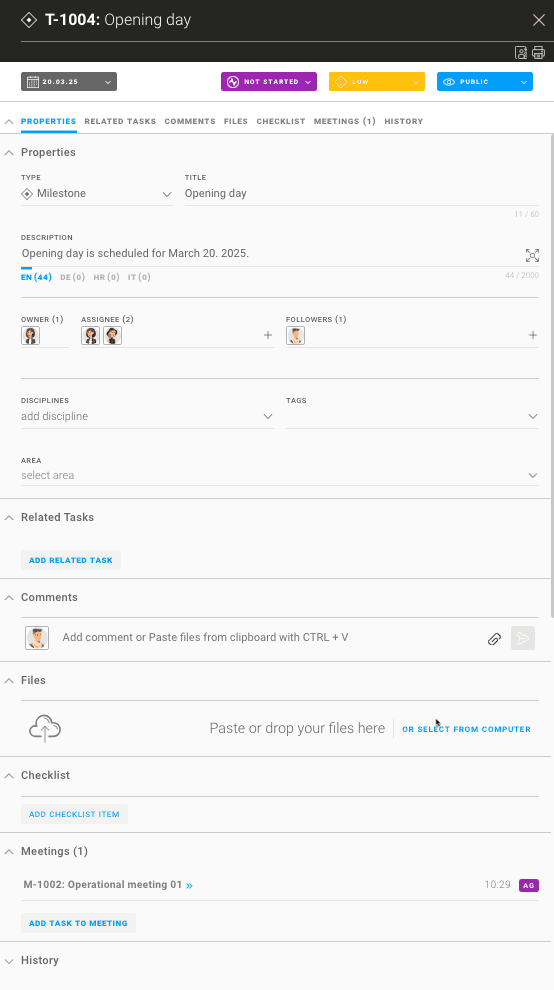
Flyout tabs
The Task Flyout Window in VOLUM3 consists of 7 tabs, each designed to manage different aspects of a task efficiently:
- Properties – Displays and allows editing of essential task properties (e.g., type, priority, due date).
- Related Tasks – Enables linking related tasks for better workflow organization.
- Comments – Allows users to add comments and images for collaboration.
- Files – Supports uploading all file types for task-related documentation.
- Checklist – Facilitates creating and managing subtasks for task completion.
- Meetings – Links tasks to relevant meetings for better tracking.
- History – Maintains an activity log of all changes made to the task.
Properties Tab
Task Title
is a short summary of the task, limited to 70 characters, providing a quick and clear overview of the task’s purpose.
Task Description
allows for a detailed explanation, including specific instructions and relevant details. The description has a 2000-character limit and can be entered in multiple languages, depending on the language settings defined in project properties.
Task type
VOLUM3 utilizes six distinct task types to facilitate project organization.
- Request for information - Used for asking questions to project participants
- For Your Information - Purely informational tasks that do not require any action.
- Decision - Tasks with a clear decision from stakeholders
- To Do - Standard work items that need to be completed
- Milestone - Represents key project checkpoints or crucial deadlines
- Issue - Captures problems that need resolution
Task Roles
Each task in VOLUM3 has three predefined roles to ensure clear responsibility and communication:
- Owner – The user who created the task. This role is non-editable.
- Assignee – The person responsible for completing the task. Ideally, only one should be assigned for clarity.
- Follower – Users who need to stay informed about the task's progress but are not responsible for its completion.
Tasks can be assigned to individuals or teams. Users can reassign tasks if responsibilities change.
People selector
The People Chooser in VOLUM3 is a small window that appears when selecting an assignee or followers for a task. It allows users to choose one or multiple people simultaneously.
The upper section displays already selected members, while the middle section contains a search bar for quick user lookup. Next to the search bar, there are four filters to refine the selection: People, Team, Company, or Discipline. The lower section lists all project members available for selection.
Discipline
Each task in VOLUM3 can be assigned a discipline (such as Architecture, Structural, or MEP) to improve filtering, organization, and retrieval within the project. Each project has a predefined set of disciplines that are set in Project Settings (link)
Tag
Tags in VOLUM3 are labels used to categorize items across all modules, including tasks, drawings, and specifications.
They can be searched, filtered, and customized to improve workflow and organization.
Users can assign multiple tags to a single item for better categorization and retrieval.
Area
The Area field in VOLUM3 tasks Window allows users to assign tasks to specific locations within a project for better organization and tracking.
Areas are predefined in the Areas module and can be assigned to one or multiple tasks if they span different locations. Users can filter tasks by area for quick access, ensuring better spatial organization and efficient task management.
Plans Link
In VOLUM3, tasks can be linked to multiple plans, allowing users to pinpoint exact locations for easier issue tracking and task management.
Clicking on a linked plan opens it in Volum3, automatically zooming to the pinned location. Tasks can be associated with multiple plans, with pins marking precise locations for clarity.
note
Linking is available only through the Plans module using the pin action, ensuring seamless navigation between tasks and project plans.
Task status bar
The Task Status Bar in VOLUM3 is located at the top of the flyout window, within the black portion of the interface. It provides a clear overview of the task’s current status, allowing users to quickly track progress and key details. The status bar includes dropdown menus for Date, Status, Priority, and Visibility, enabling efficient task management and updates.

Date
In VOLUM3, tasks are structured with key date fields to track progress and ensure timely execution.
- Start date - The date when work on the task is planned to begin
- Due Date - The deadline for task completion.
- Duration - Automatically calculated based on the Start Date and Due Date.
Task Status
Each task in VOLUM3 is assigned a status to track its progress and current state within the project workflow:
- Not Started – The task has been created but work has not begun.
- Started – Work on the task is in progress.
- Finished – Work on the task is completed, but it may still require review or approval.
- Closed – The task is officially completed and no further actions are needed.
- Reopened – The task was previously closed but has been reopened.
- Canceled – The task is no longer relevant and has been canceled.
Task Priority
Each task in VOLUM3 is assigned a priority level to indicate its urgency and ensure efficient task management:
- Low – Non-critical tasks that can be handled at a later stage.
- Normal – Standard tasks that should be completed within a reasonable timeframe.
- High – Important tasks that require prompt attention.
- Urgent – Critical tasks that need immediate action to prevent delays or issues.
Task Visibility
Each task in VOLUM3 can be set to either Public or Private to control who can view it. By default, all tasks on a project are Public, but they can be restricted when necessary.
Visibility Options
- Public – Visible to all project or stage participants.
- Private – Visible only to task owners, assignees, and followers listed in the task.
Related task tab
In VOLUM3, users can link tasks to improve workflow and track dependencies. Relationships are bidirectional and allow unlimited task connections.
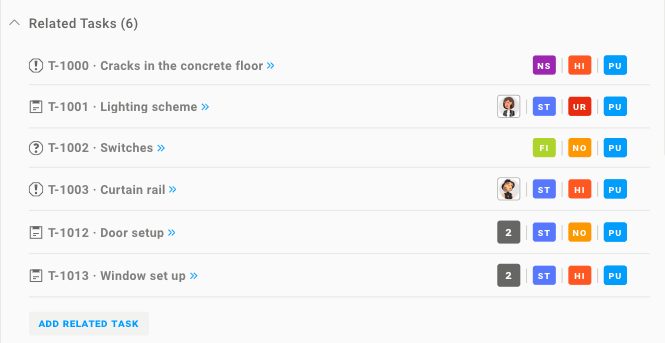
Comments tab
Users can comment on tasks and paste images for better collaboration. Each comment can trigger notification depending on your personal settings.
- Comment Editing – Edits are allowed only within 10 minutes after posting.
- Editing Restriction – If another comment is added within the 10-minute window, editing is disabled.
- Image Handling – Pasted images appear in both the comment section and the task’s files section.

Files tab
Users in VOLUM3 can upload, manage, and download files within tasks for seamless collaboration. The system supports any file type up to 100MB, with each upload automatically storing metadata such as upload time, uploader’s name, and file size.
Files can be downloaded individually or all at once as a ZIP file.
Only project editors can delete files, and all file actions (uploads and deletions) are logged in the task history for full traceability.

Checklist tab
Tasks in VOLUM3 can include a checklist to track subtasks and monitor progress on detailed work items. Users can create an unlimited number of checklist items, ensuring flexibility in task management. When an item is checked off, the date, time, and user who completed it are recorded, providing clear accountability. Checklists help break down complex tasks into smaller, trackable actions, improving workflow efficiency and task completion tracking.

Meetings tab
In VOLUM3, tasks can be linked to meetings for better tracking and organization.
The Meeting List displays all meetings where the task is featured, including the meeting name, date, and status.
Users can add a task to any active meeting or create a new meeting directly from the task interface, ensuring seamless project coordination.

History tab
All task changes in Volum3 are recorded in an activity log to ensure full traceability and transparency.
Every modification, including edits, status updates, and file uploads, is tracked with a timestamp and the name of the user who made the change. Updates are displayed in chronological order, with the latest changes at the top.
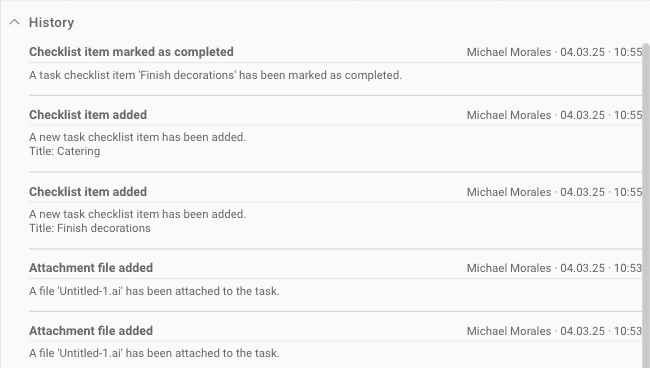
note
Regardless of the user interface language, all history entries are recorded in English for consistency across projects.
Task Actions
Task actions in VOLUM3 can be performed from the task list or the flyout window, allowing users to efficiently manage and organize tasks.
Single actions
Single actions can be accessed from the flyout window or the task list by clicking the three-dot menu on the right side of each task row:
- Print – Generates a PDF of the selected task for documentation or sharing.
- Add to Meeting – Opens a selection window where users can link the task to an active meeting or create a new meeting.
- Create Checklist – Enables users to add a checklist to break the task into smaller, trackable subtasks.

Bulk actions
Bulk actions allow users to manage multiple tasks simultaneously and are available only from the task list. When multiple tasks are selected using filters, the table header is hidden, and bulk action icons appear in the top right corner of the screen:
- Print – Exports all selected tasks as a PDF document.
- Export to XLS – Saves selected tasks as an Excel file for further analysis.
- Apply Tag – Assigns a tag to multiple selected tasks, improving categorization and filtering.
- Add to Meeting – Links all selected tasks to an existing meeting or creates a new meeting for discussion and tracking.
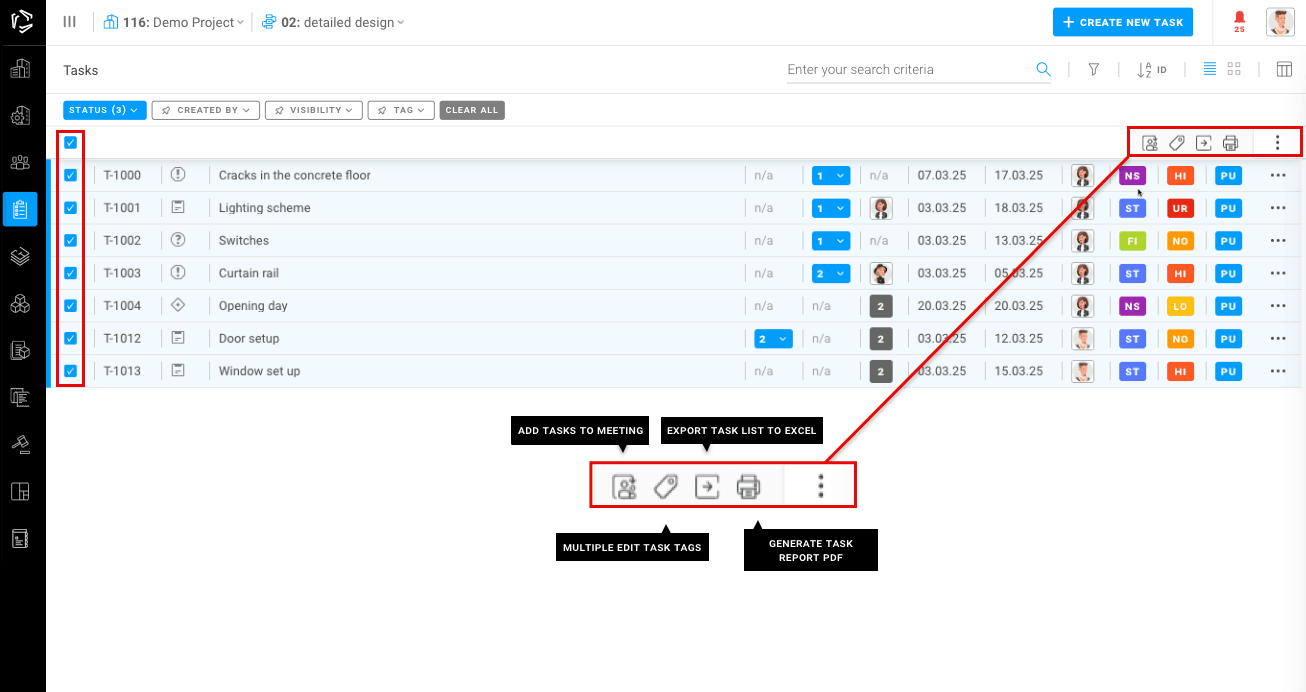
Notifications
Notifications in VOLUM3 are triggered by various task activities, ensuring users stay informed about updates and changes. Each user can individually configure their preferred notification settings, choosing between in-app notifications, email alerts, or a daily digest.
Users receive notifications when:
- A task is assigned to them or they are added as a follower.
- Someone comments on the task or uploads a file.
- The task status is updated.
- Task dates change, or a deadline is approaching.
- A checklist item’s status is updated.
- A PDF report is generated and ready for download.
For more details on configuring notifications, refer to the Notifications section in the help documentation.
